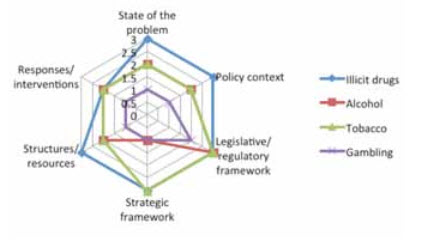Pike, Brigid (2015) New ‘policy tool’ supports transparency and open debate. Drugnet Ireland, Issue 52, Winter 2014, p. 28.
| Preview | Title | Contact |
|---|---|---|
|
PDF (Drugnet Ireland 52)
1MB |
Identifying effective approaches to creating coherent policies regarding licit and illicit drugs has been the priority of the Pompidou Group during its 2010–14 work programme. It has produced four reports on the subject. The third report, published in 2012, proposed six markers around which the concept of coherency may be said to develop:1
- conceptualisation of the policy problem
- policy context
- legislative and regulatory frameworks
- strategic frameworks
- responses/interventions
- structures and resources
In using these six markers the aim is to establish to what extent different drugs policies are in line with the concept of ‘well-being’, which is part of the World Health Organization’s overarching goal in relation to licit and illicit drugs as well as other addictive behaviours such as gambling or the Internet. At the very least, the six aspects of policy highlighted by the six markers should not be in conflict with the overarching goal, and at best should contribute to its realisation.
In 2013 and 2014 researchers refined the six markers and tested them in their countries, namely Croatia, the Czech Republic, Hungary, Ireland, Israel, Italy, Norway and Portugal, to verify whether they provided a valid tool to measure the coherency of policies on psychoactive substances with the overarching goal of the well-being. For each marker, the authors were asked to assess the level of coherency in their country, and this was then converted into a numerical value – thus, high=3, medium=2 and low=1. The results were entered in a spreadsheet and converted into a spider diagram, with the high measure on the outer perimeter. This simple graphic representation shows at a glance the strengths and weaknesses of different policies and points the way to identifying options for strengthening policy coherency.
The results published in the most recent report, Coherency policy markers for psychoactive substances, indicate that such markers may indeed be used as a basis for discussion on the issue of coherence and in some cases as a means to better implement coherent policies in respect of psychoactive substances and also possibly other forms of addictive behaviour.2
Case study – Croatia
The spider diagram contained in the report written by the Croatian Office for Combating Drug Abuse (see Figure 1) demonstrates how Croatia’s illicit drugs policy is by far the most coherent of all their policies relating to addictive behaviours, while gambling policy is the least coherent; alcohol and tobacco policies fall somewhere in between, although the strategic framework for implementing tobacco policy is substantially stronger than that developed for alcohol.
Looking at the markers rather than the policies, it is evident that Croatia’s legislative/regulatory frameworks for each policy area are the most coherent in terms of contributing to the well-being of the Croatian population as a whole, while structures/resources and responses/interventions are the areas showing least coherency. This assessment can form the basis for an open and transparent debate on how to address the shortcomings.

Figure 1: Summary of the assessment of six markers for coherence of policies on illicit drugs, alcohol, tobacco and gambling, Croatia
The authors of the Croatian report describe how they facilitated discussion. After the relevant bodies and experts in charge of the co-ordination and implementation of policies on psychoactive substances and addictive behaviour had assigned values (high, medium or low) for each of the six makers, these same people were invited to form a focus group in order to give more detailed insights into the issues and to clarify any ambiguities. In addition, there was a detailed analysis of the key strategic documents. On the basis of this ‘triangulation’, the authors were able to identify a series of specific actions to strengthen the coherency of addiction policies.
- Muscat R, Pike B and Members of the Coherent Policy Expert Group Pompidou Group (2012) Reflections on the concept of coherency for a policy on psychoactive substances and beyond. Strasbourg: Council of Europe.
- Muscat R, Pike B and Members of the Coherent Policy Expert Group Pompidou Group (2014) Coherence policy markers for psychoactive substances. Strasbourg: Council of Europe.
Repository Staff Only: item control page